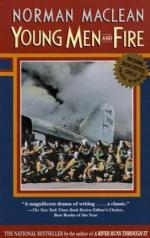|
This section contains 3,071 words (approx. 8 pages at 400 words per page) |

|
Part One Summary and Analysis
According to Maclean, the Smokejumpers in 1949 were not far from their original purpose as parachute jumpers, who often turned into stunt performers at county fairs. At the same time, they were also the best firefighters in the Forest Service. Yet many did not realize that they were still relative newcomers to fighting forest fires. The first parachute jump was made in 1940; the Smokejumpers were officially organized in 1941.
The Forest Service was introduced in the 1905 about the same time as the airplane. Maclean states that the airplane was the most effective invention in fighting forest fires. By 1925, planes were used to help spot fires, replacing scattered lookouts. By 1929, supplies were being dropped to firefighters from airplanes, and it seems logical that the firefighters would soon drop from the airplanes as well. There were equipment and psychological difficulties that prevented parachute...
(read more from the Part One Summary)
|
This section contains 3,071 words (approx. 8 pages at 400 words per page) |

|




